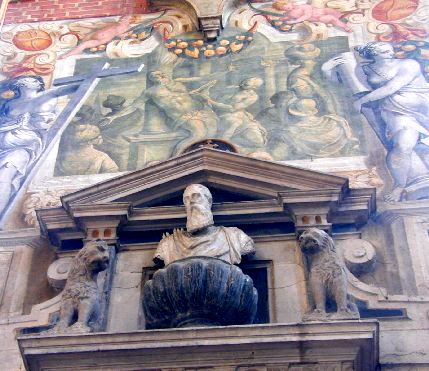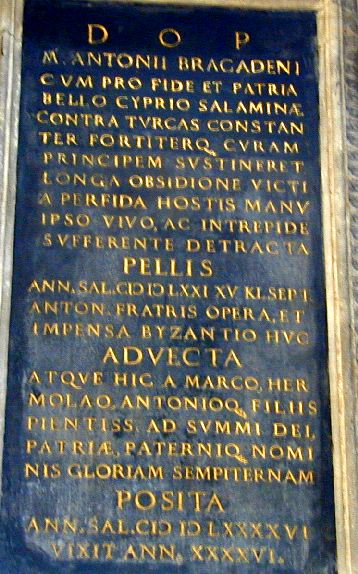
Churches in Europe, Dan’s Perspective
Now that we all know what Doreen thinks of the churches in Italy and France, I thought that I would offer my somewhat more naive view of the same matters, and also let you know some of the amazing things that we have seen inside there churches here in Italy.
I have gone into ALMOST as many churches as Doreen has here. Occasionally, (VERY occasionally) Doreen decided that she wants to be alone in a given church, and I, of course, being the sweet guy I am, let her go off without protest. In any case, we have been to about a million churches and cathedrals in France, and almost as many here in Italy. Whenever we go to a new city, the first thing we do to visit all the churches. (ed. Note – the first thing we do in a new city is buy beer – only after we have replenished our supplies will I let Dan go into a church – despite his begging and pleading. dns) Big, little, old, new, it doesn’t really matter, as long as they are churches.

A small fraction of the French Churches we visited.
In France, it seemed that all the Churches were crowed with stuff, and soaring. They seemed to be exclusively places of worship, rather than places of personal aggrandizement. (In Italy, if you want to secure for yourself a place in heaven, you also wanted a large place in your church. For your coffin) Now, what I mean by places of worship is that they were BUILT as places of worship, rather than as places to "remember" a certain nobleman. Today, it is a much different story, as Doreen has already attested to.
When you walk into a French church, you will notice (At least the 530 WE went into) that they are virtually all gothic. They have plenty of filigree, doodads, details, and, (amazingly enough) chairs. Even in Chartres, where they have a beautiful Labyrinth on the floor in stone, they have chairs set in the nave from pillar to pillar. (The Labyrinth in Chartres was built for penance, you were supposed to walk it on your knees while repeating the rosary. It was supposed to have taken an hour to do so. I would have done so, but there were chairs covering the path.) You will also notice plenty of stained glass. Now, much of this glass is replacement glass from the 18th century, but it is stained glass none the less. (In Chartres, the Virgin Mary told them where to put the colored glass, and where to put the grisailles windows. Those were the ones that let in light, because there was no real way to artificially light these spaces.)

French Stained Glass
The other amazing thing about the French churches is the flying buttresses. Now, I don’t know about any of you, but I grew up hearing about flying buttresses. Because of course, you need to distribute the stress from the edifice (that soaring space I mentioned about) to the ground, without causing the structure to collapse in on itself. And to see them in person was a real treat – an amazing feat of engineering. You know that it was the engineer who had to put them in, because the architect goofed up with the design inside. But they are indeed a wonderful (though space consuming) way to solve the problem of how to have very high ceilings without having to have really thick walls.

Flying Buttresses. (On the right side of the image)
Now, you get into the Italian churches, and the very first thing you realize if that they are OPEN. There are beautiful colored floors, (mostly orange and white marble) and thick pillars, but NO CHAIRS! The other thing you notice is the lack of stained glass. It is so remarkable when you see it, that you always notice it. There are many more small chapels, and MANY more reliquaries in Italian churches. (We saw St Dominic’s head. I am not kidding – St Dominic as in the Dominicans. He was staring out from a beautiful reliquary in Bologna. More on Bologna later) Fingers, hands, feet, heads (which see) femurs, you name it, they have it setting in a gold box in an Italian Church. But that is far from the most amazing thing that you see in these churches.
Many of the churches, at least here in Venice (and perhaps I should restrict my comments to Venetian, Ferraran, and Bolognese churches) also served as displays of wealth for the local gentry. The Doges, the Group of Ten, the Council of Trent, they all had to show how rich they really were. They did this by building tombs.

The Fraris Cathedral
Some of you may be aware of the Slaves that Michalangelo was carving when he died. They were supposed to be for Pope Julius’s tomb in Rome. Well, these slaves have nothing on the various tombs we was here in Venice.

Flocked wallpaper? No, that is all inlaid marble. Every bit of it!
One of the folks whose tomb we saw was the Venetian Commander of the battle of Ventano. His was the Doge Sebastiano Venier. Here is a friend’s description of the battle, taken, unauthorized, from an e-mail he sent chiding me that we did not see enough military history. (Thank you John Sherman, currently a Big Doge at Dell. SO if you have problems with your Dell computer, you can e-mail him at [email protected] and he will solve your problems.) Anyway, his description of the battle:
...Lepanto, as in "battle of." Venetians 1, Turks 0. Allied fleet quarterbacked by Don Juan (not THE Don Juan, if I remember correctly). He danced on the galley oars before the battle in sight of the enemy. Right up there with Roland. The night before the battle, the barbary pirate Ali slipped into the midst of the Venetian fleet to count them in an all-black galley. They should have made an Errol Flynn movie of this in 1945.
- John
So there you have it. In any case, he has a BRONZE STATUE in Saints John & Paul church, along with a monument to Marcantonio Bradadin, who was the commander of the last Venetian outpost of empire, that in Cyprus. In 1571 he heroically held on until he could hold no more, and then negotiated an honorable peace with the Turks. He arranged to hand over the keys to the city himself, and the Turk commander replied in courteous words that he would be honored to receive him. What happened was described in the Quarterly Review in October 1874 (This is from VENICE: A Literary Companion, by Ian Littlewood. I cannot recommend this series highly enough.)
Bragadino came, attended by the officers of his staff, dressed in his purple robes, and with a red umbrella, the sign of his rank, held over him. In the course of the enduing interview, the Pasha suddenly springing up, accused him of having put some Mussulman prisoners to death: the officers were dragged away and cut to pieces, whilst Bragadino was reserved for the worst outrages that vindictive cruelty could inflict. He was thrice made to bear his neck for the executioner, whose sword was thrice lifted as if about to strike: his ears were cut off: he was driven every morning for ten days, heavy laden with baskets of earth, to the batteries, and compelled to kiss the ground before the Pasha’s pavilion as he passed. He was hoisted to the yard-arm of one of the ships and exposed to the derision of the sailors. Finally, we was carried to the square of Famagosta, stripped, chained to a stake on the public scaffold, and slowly flayed alive, whilst the Pasha looked on. His skin, stuffed with straw, was then mounted on a cow, paraded though the streets with the red umbrella over it, suspended from the bowsprit of the admiral’s galley, and displayed as a trophy during the whole voyage to Constantinople. The skin was afterwards purchased of the Pasha by the family of Bragadino and deposited in the church of SS Giovani e Paolo.
There is a fresco in the church showing Bragadino being flayed alive, and there is the urn with his skin. They have a little brochure that tells more or less the same story, with a little less detail, but adding that Bragadino did not call out in pain during any part of his torture. Even when he was being flayed, he was silent until he died, which was as they reached his waste.

flayed guy. You can see the fresco of his flaying above the bust.

Tribute to the flayed guy in Latin. One of Doreen's guide books said that you could not read this without tears coming to your eyes. I could, because I cannot read Latin. Maybe some Latin speaking person will e-mail me the translation…
Nasty stuff to have in a Church, eh?
Additionally, there are tombs for the really big dog Doges, and you can barely believe your eyes when you see them. In the church called Fraris, another Gothic (as opposed to Romanesque or Baroque) there is a tomb that must be four stories high. They have four HUGE black slaves holding up the lintel on which is placed the sarcophagus, with skeletal figures looking out into the church.

Blackamoor Pillars in the Frari

The Tomb with The Blackamoors, for scale.
One of the tombs has a statue of the Dogeressa who is VERY homely. There is also a lion of St Mark who looks like a begging dog. It was very sad to see.

Dan making Doreen go into "just one more" church.
Some of you more attentive readers will notice that Doreen takes her job as editor very seriously. I always let her have the "last cut" before posting these stories.